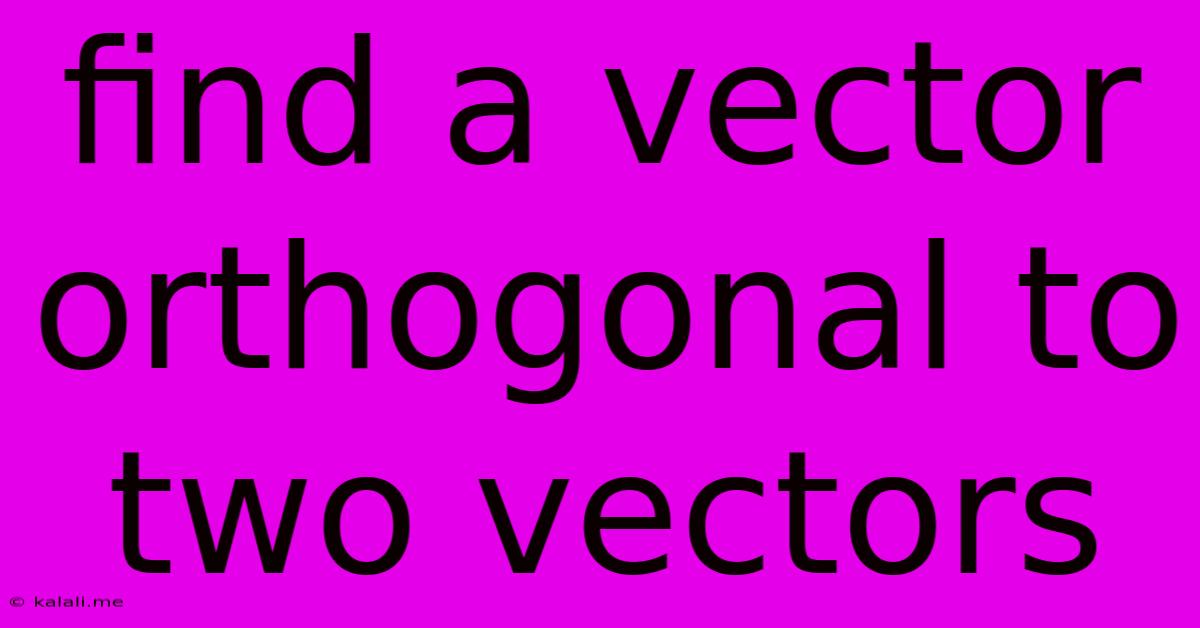Find A Vector Orthogonal To Two Vectors
Kalali
May 29, 2025 · 3 min read

Table of Contents
Finding a Vector Orthogonal to Two Given Vectors
Finding a vector orthogonal (perpendicular) to two given vectors is a fundamental concept in linear algebra with applications across various fields like computer graphics, physics, and machine learning. This article will guide you through the process, explaining the underlying principles and providing practical examples. Understanding this concept is crucial for tasks such as calculating normal vectors, determining plane equations, and solving systems of linear equations.
What does "orthogonal" mean? Two vectors are orthogonal if their dot product is zero. The dot product measures the projection of one vector onto another. If the projection is zero, it means the vectors are perpendicular.
The Cross Product: A Powerful Tool
The most common method for finding a vector orthogonal to two other vectors in three-dimensional space (R³) is using the cross product. The cross product of two vectors, a and b, results in a vector c that is orthogonal to both a and b.
The cross product is defined as follows:
Let a = (a₁, a₂, a₃) and b = (b₁, b₂, b₃). Then the cross product c = a x b is given by:
c = (a₂b₃ - a₃b₂, a₃b₁ - a₁b₃, a₁b₂ - a₂b₁)
This can be remembered using the determinant of a matrix:
| i j k |
| a₁ a₂ a₃ |
| b₁ b₂ b₃ |
where i, j, and k are the unit vectors along the x, y, and z axes respectively.
Example: Finding an Orthogonal Vector
Let's find a vector orthogonal to a = (1, 2, 3) and b = (4, 5, 6).
Using the cross product formula:
- c₁ = (2 * 6) - (3 * 5) = 12 - 15 = -3
- c₂ = (3 * 4) - (1 * 6) = 12 - 6 = 6
- c₃ = (1 * 5) - (2 * 4) = 5 - 8 = -3
Therefore, the vector c = (-3, 6, -3) is orthogonal to both a and b. You can verify this by calculating the dot products: a • c = 0 and b • c = 0.
Important Considerations:
-
Uniqueness: The cross product produces only one vector orthogonal to the two given vectors. However, any scalar multiple of this vector will also be orthogonal. For example, (3, -6, 3) is also orthogonal to a and b.
-
Zero Vector: If the two input vectors are parallel (or linearly dependent), their cross product is the zero vector (0, 0, 0). This is because parallel vectors don't define a unique plane, and thus, there isn't a unique normal vector.
-
Two-Dimensional Space (R²): The cross product is not directly applicable in two dimensions. However, you can find an orthogonal vector by swapping the components and negating one of them. For example, if you have vector a = (x, y), then an orthogonal vector is b = (-y, x).
-
Higher Dimensions: For vectors in higher dimensions (R⁴, R⁵, etc.), more sophisticated methods like the Gram-Schmidt process are needed to find orthogonal vectors.
Applications:
The ability to find orthogonal vectors is critical in many applications:
- Computer Graphics: Calculating surface normals for lighting and shading.
- Physics: Determining the direction of a force or torque.
- Machine Learning: Feature extraction and dimensionality reduction techniques.
- Robotics: Calculating joint angles and orientations.
By understanding the cross product and its properties, you can effectively find vectors orthogonal to two given vectors, opening doors to solving complex problems in various domains. Remember to check your results by computing the dot products to ensure orthogonality.
Latest Posts
Latest Posts
-
Add Xframe Header On Your Page
May 30, 2025
-
How To Login As Root Wihtout Sudo
May 30, 2025
-
Give User Permission To Folder Linux
May 30, 2025
-
How Did Frank End Up In Mexico
May 30, 2025
-
Why Can I Check In To European Flights So Early
May 30, 2025
Related Post
Thank you for visiting our website which covers about Find A Vector Orthogonal To Two Vectors . We hope the information provided has been useful to you. Feel free to contact us if you have any questions or need further assistance. See you next time and don't miss to bookmark.